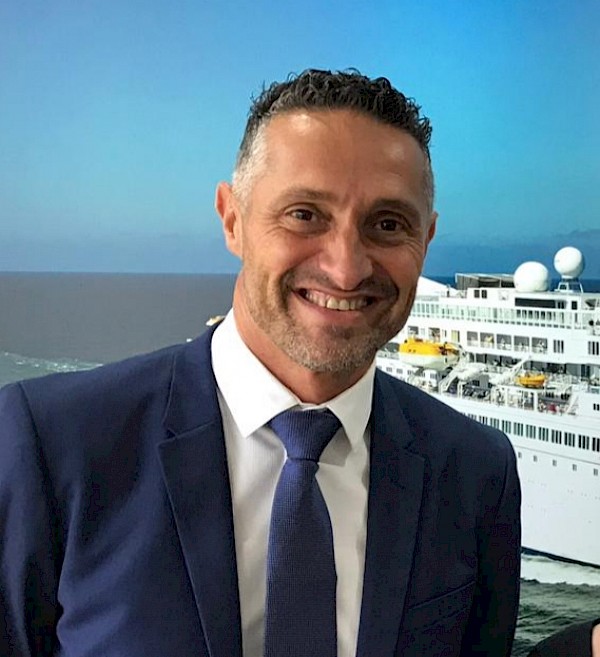Thursday, November 26, 2020 - 09:50 by ce-press
David Castro, commercial management Port of Vigo, was in no doubt that the Bermello Ajamil (BA) webinar was very interesting and helpful, and a good opportunity to update the information on how the pandemic is being faced in the different countries and ports of the world. He told CE: “We especially liked the development of the bubble concept in its different meanings, and the monitoring of the first experiences of resuming the activity.
“But, without a doubt, what has seemed most useful to us is the last one part ‘Moving Forward’, with proposals for the planning that the ports have ahead of us to really be able to resume cruise traffic in the best conditions.”
Below he responded to questions posed by CE:
What might the content of the webinar mean for Vigo?
It has been useful in terms of knowing the different scopes of the ‘bubble’ concept, depending on the geographical and physical possibilities of each port and each destination. It is also interesting to be up to date with the evolution of the protocols in each of the regions and, particularly, those related to the experience in Europe.
The last section ‘Moving Forward’, in my opinion, lays the foundations for planning the resumption of activity in a clear and precise way.
What measures might Vigo put in place due to the webinar?
The port of Vigo, being within the system of Spanish State Ports, is subject to the supervision of the national and regional health authorities, so the measures to be implemented will be conditioned by the regulations published at the time by the Spanish government.
At this time, cruise traffic is still suspended in Spain with the exception of the Canary Islands, and within specific conditions for some cruise companies. The outcome of this first attempt will probably serve as a guiding line for the instructions that the government will issue for the rest of the Spanish ports.
In any case, a regulation has already been approved that requires ports to have a separate space for the management of a ‘secondary’ sanitary control - after the first one that must initially be carried out on board the ships - where medical personnel can carry out interviews or appropriate tests when there is a suspicion of contagion.
In the port of Vigo there are two cruise terminals, with two different terminal operators, which are already designing, in coordination with the Port Authority and the health authorities, the basic measures of social distance, temperature control, signalling etc, within each one of the terminals.
Perhaps Vigo has already made some changes?
At the moment, a separated space for sanitary control has been prepared, as established by the regulations of the Spanish government, and a committee has been created composed of the terminal operators, the Port Authority and the health authority to evaluate the protocols and establish the measures in a coordinated way.
How easy will it be to make the required changes, both operationally and in terms of infrastructure?
While waiting to know exactly the scope of the changes to be made, for now the effort is concentrating on establishing the availability of spaces and coordinating the information. In terms of infrastructure, the Maritime Station that houses the two terminals has spaces already reserved in anticipation of the needs that may exist to meet the Covid protocols. Operationally, the Port Authority is in contact with the terminal operators to unify the criteria and collaborate in the management of the changes that may be necessary.
Will this require extra investment, which perhaps is not available?
Of course, an additional investment will be required, but at the moment it is not defined who will be responsible for it. A joint effort between the (private) terminal operators and the Port Authority, the (public) manager of port infrastructures, will probably be necessary.
How much of a challenge will it be and does it feel like a hill or a mountain to climb?
In the case of the port of Vigo, given the characteristics of the infrastructures and the extensive experience in managing the calls of large and small cruiseships, we face this challenge with great responsibility and seriousness, but with the confidence that our coordination between all the agents involved will be key to smooth the slope of this great challenge.
An advantage in the case of the port of Vigo is the extensive hospital and health facilities available, one of the reasons why it was selected by the Spanish government as one of the nine Spanish ports ‘Point of Entry with the capacity to attend to Public Health Emergencies of International Importance’.
Furthermore, in terms of destination, although the port of Vigo can hardly design bubble areas within the port or parts of the city, given that the cruise terminals are located in the very centre of the city, Vigo does have a wide range of activities that allow the development of passenger bubbles, such as nature and maritime tourism, with a large number of activities in its sheltered estuary and the Cies Islands National Park, visits to wineries, the local gastronomic offer, etc.
How many calls did Vigo receive last year and were due to receive this year?
Last year (2019) the port of Vigo hosted 71 cruise calls, and in 2020, before the pandemic, Vigo was supposed to receive 72 calls, but ended being, up to now, only 7 calls (those from before mid-March).
How many do you still have planned next year?
For 2021, the forecast is to maintain the same proportion of calls, between 70 and 75.
